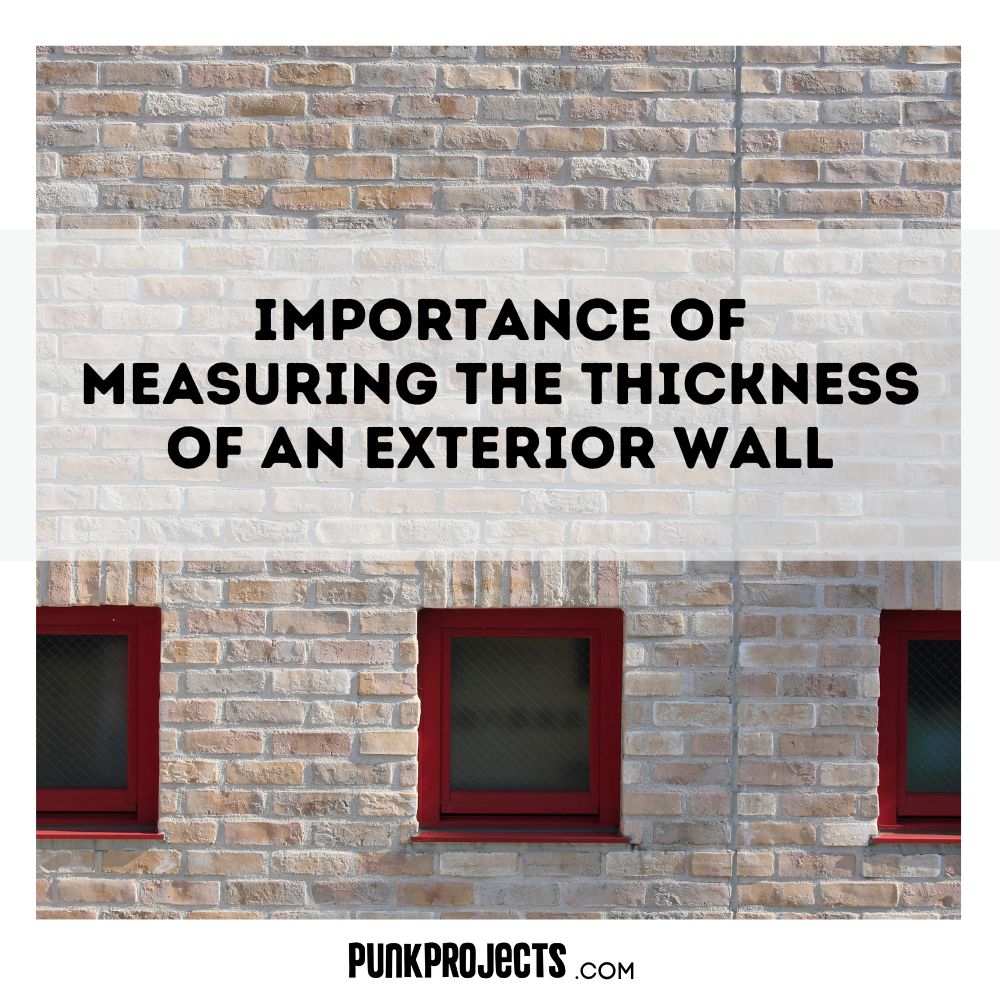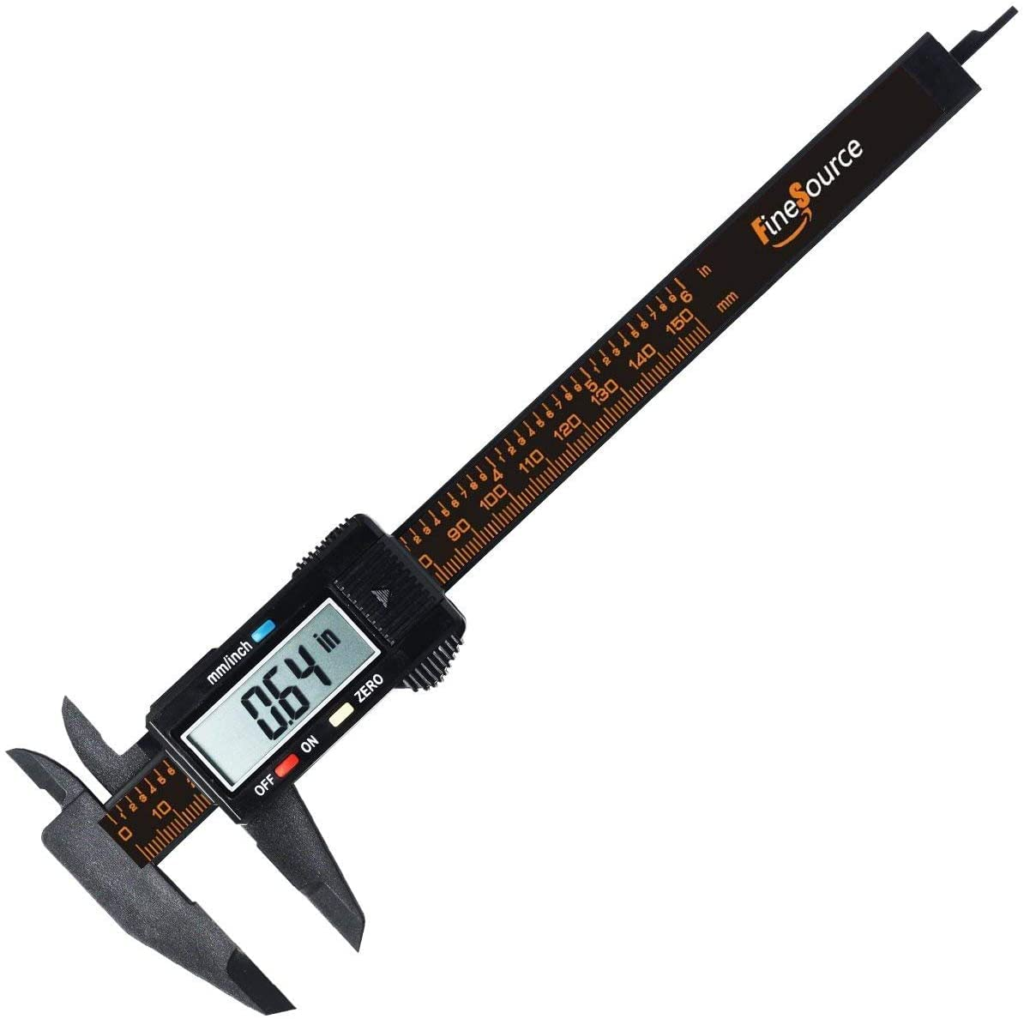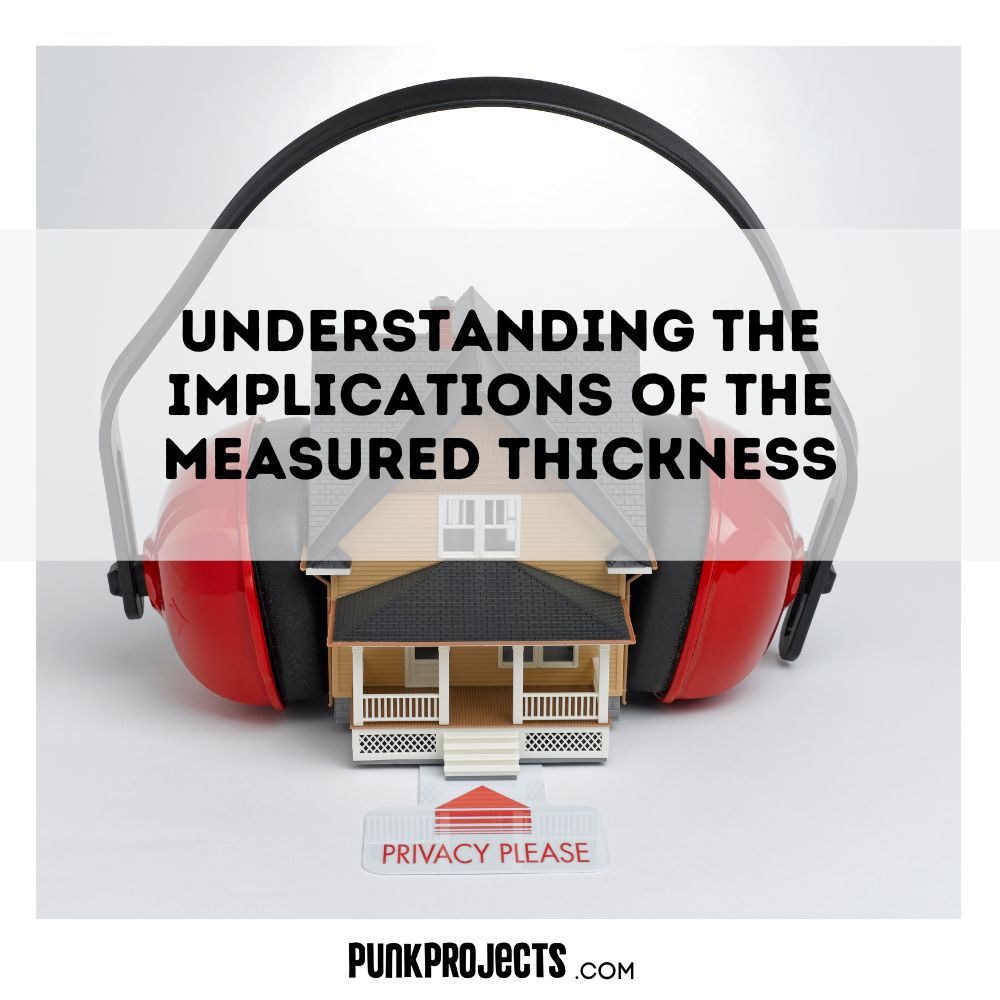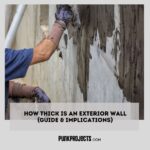Exterior walls – the backbone of a building’s structure – are vital to shielding us from weather and maintaining indoor comfort. So, How Thick Is An Exterior Wall?
These walls act as barriers between interior and exterior environments, protecting inhabitants from rain, wind and heat. Wall thickness affects insulation and soundproofing.
Type of construction materials used determines how thick walls need to be. For example, brick and stone walls are thicker than modern materials like concrete blocks and lightweight steel frames.
Climate conditions also play a role. Areas prone to extreme weather require thicker walls for thermal insulation and structural stability.
To illustrate this, consider medieval European castles. Their walls were built several feet thick, using stone or brick, to withstand attacks and weather. A testament to our ancestors’ engineering prowess!
Importance of measuring the thickness of an exterior wall

An exterior wall’s thickness is key for a building’s strength and insulation. Measuring it is essential for architects, engineers, and contractors. It allows for accurate blueprints and insulation material choices for thermal performance and energy savings. Cost calculations are also more exact, averting costly overruns.
Maintenance is simpler when the wall thickness is known. It helps identify any issues like degradation or moisture, and enables repairs and renovations.
Materials and climate conditions influence the thickness necessary. Concrete walls generally need to be thicker than wood-framed ones. Ancient Egyptians mastered this when constructing pyramids – their commitment to detail remains awe-inspiring.
Today, measuring exterior wall thickness is fundamental. It ensures structural integrity, energy efficiency, and quality craftsmanship.
Tools required for measuring the thickness
The tools required to measure the thickness of an exterior wall can vary depending on the materials used and the accuracy needed. Some common tools include a tape measure, calipers, laser measure, or ultrasound equipment.
Here is a table outlining the different tools and their uses:
| Tool | Description |
|---|---|
| Tape measure | A flexible measuring tape used for linear measurements. |
| Calipers | Used to measure the thickness of small objects with precision. |
| Laser measure | Utilizes laser technology to measure distances accurately and quickly. |
| Ultrasound equipment | Uses sound waves to measure the thickness of materials without causing damage. |
It is important to note that different tools may be more suitable for specific situations. For instance, tape measures are commonly used for quick measurements, while ultrasound equipment is often used in construction projects to assess the integrity of building materials. Additionally, calipers are ideal for measuring narrow or small objects, while laser measures provide quick and non-contact measurements.
As a pro tip, always ensure that the tools you use are appropriately calibrated and in good working condition to obtain accurate measurements.
Why bother measuring the thickness of an exterior wall when you can just knock on it and hope for the best? It’s like playing a game of architectural roulette!
Measuring tape

A measuring tape can range from a few feet to several meters long. It is usually made of durable steel or nylon and has clear, easy-to-read measurement markings. It also has a locking mechanism to help keep measurements secure.
Modern measuring tapes have extra features like magnetic tips for sticking to metal surfaces or laser-guided measurements. To be accurate, it’s important to use a properly calibrated and maintained measuring tape. Inspect and clean it regularly. Also, use the right techniques to get consistent results.
Don’t miss out! Get a reliable measuring tape for accurate measurements. Make your projects more professional and efficient. Add this essential tool to your toolbox and enjoy precise calculations – no more guesswork!
Stud finder

Stud finders are a must-have for measuring wall thickness and finding the studs inside. They detect density changes, helping you locate important structural elements. These tools show wall thickness and can detect wood and metal studs, wires, and pipes behind walls. Most stud finder types have handheld devices with visual or audible warnings when a stud is detected.
Magnetic stud finders use magnets to locate metal studs. Advanced ones offer extra features like live wire detection and scanning modes. Today’s stud finders are more sensitive and accurate than older models.
Paul, a homeowner, needed to mount a heavy mirror. He used a stud finder which showed an empty space. Thanks to the exact readings, he could fix it securely and prevent potential damage.
Digital caliper

A digital caliper can measure objects up to 6 inches in length with an accuracy of 0.001 inch. It has a resolution of 0.0005 inch for precise measurements. This versatile tool is made of stainless steel, making it durable and resistant to wear and tear. It also has handy features such as a depth gauge and an inside/outside measurement function. So, it’s suitable for varied measurement tasks that require utmost accuracy.
Step-by-step guide on measuring the thickness

A professional way to approach the topic of measuring the thickness of an exterior wall is to provide a step-by-step guide. Here is a concise and informative outline:
- Identify a suitable location: Find a section of the exterior wall that is accessible and representative of the wall’s overall thickness.
- Gather necessary tools: Prepare a measuring tape, a level or square, and a pencil.
- Measure the thickness: Place the level or square against the wall vertically and align it with the chosen spot. Use the measuring tape to determine the distance between the outer surface of the wall and the back of the level or square. This measurement will give you the thickness of the exterior wall at that location.
As for some additional details, it’s important to note that the thickness of exterior walls can vary based on factors such as the construction material used, the age of the building, and the specific design requirements. It is recommended to measure the thickness at multiple locations to get an accurate average.
Now, let’s share a true story related to measuring exterior wall thickness.
Why bother measuring an exterior wall when you can just assume it’s as thick as a politician’s skin?
Preparation before measuring
- To measure correctly, prep is key. Follow these few steps for reliable readings.
- Gather the equipment you need. This may include a tape measure, ruler, or caliper, based on the thickness of the object. Make sure they are clean and in good condition.
- Choose a flat, stable surface for the measurements. This way the object stays still and the readings will be accurate.
- Zero the measuring tool. Put it on a level surface and adjust it to 0. This eliminates errors due to calibration issues.
- Take multiple measurements at different points. This helps to reduce errors from uneven surfaces or inconsistent thickness.
- Maintain steady hands throughout the process. Any movement can lead to inaccurate readings.
- With proper preparation, you get precise results. Remember that prep is essential for accurate measurements.
Clearing the area around the wall
Before measuring the thickness of a wall, clear the area around it. This includes:
- Removing any furniture or objects such as chairs, tables, and shelves.
- Using a broom or vacuum cleaner to clean the surface.
- Placing drop cloths or plastic sheets over nearby surfaces to prevent damage.
- Ensuring there is sufficient light in the area.
This creates a clean workspace and enables accurate measurements.
Safety First: Before starting any project involving walls, use a stud finder or seek professional help to check for electrical wires and plumbing pipes behind the wall.
Ensuring safety precautions
Safety is key when measuring thickness! To ensure a safe process, these steps must be taken:
- Ready the area: Clear any obstacles and make sure the lighting is good for accuracy.
- Wear protective gear: Wear gloves, safety goggles, and a lab coat for safety.
- Inspect equipment: Check the instrument for any damage or malfunctions. If needed, contact the right people for help.
- Calibrate the device: Make sure the instrument is calibrated properly.
- Stand at a distance: Don’t stand too close to anything moving or dangerous. Keep a safe distance.
Remember, regular maintenance of the equipment is essential for safety and performance.
Stay cautious and make safety your priority – these steps will help keep you safe and give accurate measurements.
Measuring the thickness using a measuring tape
- Put the measuring tape at the beginning of your object.
- Stretch it along the surface until you get to the other end.
- Observe the measurement on the tape when it meets the other edge. This will be the thickness of your object.
Be careful not to miss out on accuracy. Make sure the measuring tape lies flat and there are no obstacles in the way.
Accurate measurements are important for many uses, like carpentry, engineering, or even to check the thickness of paper.
So, grab your measuring tape and measure with confidence!
Measuring the thickness using a stud finder
Need to measure the thickness of an object? We’ve got you covered! Follow these steps and you’ll make it a breeze.
- Position the stud finder: Place it firmly against one side of the object.
- Slowly move across: Move it slowly across the surface. It will show precise measurements as it goes.
- Note down the measurements: Take note of any readings displayed on the screen. This will give you the minimum and maximum thickness points.
Stud finders are great for walls too! They can help find studs and measure thickness without causing damage. “Home Improvement Magazine” says using a quality finder can save time and effort.
Measuring the thickness using a digital caliper
- Turn on the digital caliper and set it to zero. Clean the measuring surfaces.
- Place the object between the caliper’s measuring surfaces. Close the jaws until they touch both sides.
- Note the measurement on the screen. See if it’s in inches or millimeters.
- Record the reading and take more if needed.
Plus, measure multiple points of the object to ensure accuracy. This helps avoid errors from irregularities in thickness.
Understanding the implications of the measured thickness

The thickness of an exterior wall plays a significant role in the construction and design of a building. It determines the structural integrity, insulation, and soundproofing capabilities of the wall. The implications of the measured thickness can vary depending on the specific requirements and regulations of the project.
To better understand the implications of the measured thickness, let’s explore some factors that need consideration.
| Factors | Measurements |
|---|---|
| Structural Integrity | The thickness of the exterior wall contributes to the overall strength and stability of the building. It should be able to withstand the load it is designed to bear, whether it’s the weight of the roof or the pressure of lateral forces such as wind or earthquakes. |
| Insulation | Thicker walls provide better insulation, reducing heat transfer and energy loss. They help maintain a comfortable indoor temperature and can result in cost savings on heating and cooling. |
| Soundproofing | The thickness of the wall can also affect its ability to block sound transmission from outside or between different parts of the building. Thicker walls with multiple layers or insulation materials can offer improved soundproofing qualities. |
It’s important to note that specific building codes and regulations might dictate the minimum thickness requirements for exterior walls based on factors such as the climate, building type, and fire safety.
Understanding the implications of the measured thickness allows architects, engineers, and designers to make informed decisions about material choices and construction methods. By considering the structural, insulation, and soundproofing aspects, they can create buildings that meet the required standards while ensuring comfort and energy efficiency.
In light of this information, it becomes apparent that the measured thickness of an exterior wall is not a trivial matter. It affects various aspects of building design and performance, making it a crucial consideration in construction projects.
In true history, the understanding of wall thickness dates back centuries, with ancient civilizations using a variety of materials and techniques to construct walls of different thicknesses for various purposes. From the defensive walls of ancient fortresses to the intricately designed walls of palaces and temples, the thickness played a vital role in determining the strength, functionality, and aesthetics of these structures. Today, with advancements in building materials and construction technology, the measurement and understanding of wall thickness continue to be an important aspect of architectural and engineering practices.
When it comes to exterior walls, thickness ranges from ‘paper-thin’ to ‘seriously, it could stop a tank.’ Welcome to the diverse and unpredictable world of construction!
Common thickness ranges for exterior walls
Concrete walls span 8-12 inches thick, for strength and stability. Brick walls range 4-10 inches, providing insulation. Wood walls usually come in 6-8 inches, having both natural beauty and practicality. Vinyl siding is usually 0.04-0.05 inches, with its lightweight and low maintenance. Stucco walls are generally 0.875 inches, offering durability and weather resistance.
Knowing these ranges helps architects and builders decide based on project needs. To optimize wall thickness, consider: insulation, sheathing, soundproofing and waterproofing. Doing this ensures performance while considering individual project needs.
Read Also : 15 types of exterior house stone (Favorite & Lightweight)
Factors influencing exterior wall thickness
Various factors influence exterior wall thickness. These need to be carefully considered for structural stability and meeting safety standards. A table below lists the key factors and their descriptions:
| Factors | Description |
|---|---|
| Building Height | Taller buildings require thicker walls due to wind forces and structural loads. |
| Climate Conditions | Extreme temperatures or high humidity may necessitate thicker walls for insulation. |
| Type of Construction Material | Different materials, such as concrete or wood, have varying strength properties, thus affecting wall thickness. |
| Purpose of the Building | Buildings used commercially might require thicker walls due to increased foot traffic and damage risks. |
| Local Building Codes | Municipal regulations often mandate minimum wall thickness for safety and compliance with standards. |
In addition, other details like acoustic insulation, fire resistance specifications, and energy efficiency needs must be taken into account.
Here are some suggestions to effectively address these considerations:
- Consult an experienced architect/structural engineer: They can help select the right wall thickness based on the building’s needs.
- Research local building codes: Understanding these regulations in your area is crucial to avoid violations and meet safety standards.
- Evaluate material options: Different materials offer distinct advantages and disadvantages in terms of strength, durability, and insulation. Choose materials that align with project goals while considering their impact on wall thickness.
- Consider future maintenance needs: Incorporating space for future repairs or additions can save time and costs without compromising the integrity.
By following these suggestions, architects and builders can make informed decisions about exterior wall thickness. This results in safer, more functional, and aesthetically pleasing structures.
Conclusion
Analyzing wall thickness is very important. Materials, building codes, and structural needs must all be taken into account. Climate & energy efficiency also must be considered. Insulation materials should prevent heat exchange. Architects & builders must use these factors to create durable & sustainable structures.
For better performance, installers must ensure a seamless integration of the wall’s layers. Exterior cladding must be weather-resistant too. Lastly, sound insulation is key, with thicker walls reducing noise from outside. Sound-absorbing materials or techniques can further improve this.
Frequently Asked Questions
What factors determine the thickness of an exterior wall?
The thickness of an exterior wall is determined by factors such as the building’s structural requirements, climate conditions, insulation needs, and local building codes. Additionally, the type of construction, such as wood frame or masonry, can also influence wall thickness.
Are there any standards or regulations for exterior wall thickness?
Yes, there are building codes and regulations that dictate the minimum requirements for exterior wall thickness. These codes ensure structural integrity, insulation, and fire safety. It is important to consult local building authorities or professionals to adhere to the specific regulations in your area.
Can exterior walls be made thicker for added insulation or other purposes?
Yes, exterior walls can be made thicker to accommodate additional insulation or for specific purposes. This can help improve energy efficiency, soundproofing, or provide space for wiring and plumbing installations. It is recommended to consult with architects or contractors to determine the feasibility and best options for thicker walls.
How does wall thickness affect energy efficiency?
Thicker exterior walls can provide better insulation, reducing heat loss or gain and increasing energy efficiency. The additional space allows for more insulation material, enhancing the wall’s ability to resist thermal transfer. However, other factors like insulation quality and proper installation also play significant roles in energy efficiency.
Are there any alternatives to thick exterior walls for insulation purposes?
Yes, there are alternative methods for insulation purposes that don’t necessarily involve thicker walls. These include using advanced insulation materials, such as spray foam or rigid foam boards, which have higher insulation values per inch compared to traditional methods. Additionally, exterior insulation and finishing systems (EIFS) or insulated concrete forms (ICFs) can provide efficient insulation without significantly increasing wall thickness.
I am a multi-talented designer and contractor with over 10 years of experience in the field. I have a passion for creating beautiful, innovative spaces that reflect my clients’ needs and styles. My skills include architectural design, interior design, space planning, project management and construction supervision.






